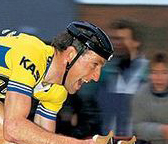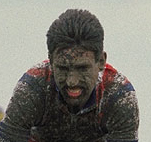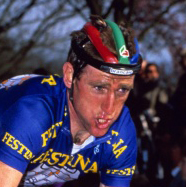Suffering and its management is a central element of cycling
By Tom Daly
(A version of this article appeared in Cycling Weekly magazine in October 2017 entitled ‘Why cyclists love to suffer’)
The Enigma of Suffering
 Some years ago I began saving images of Seán Kelly that I randomly came across on the internet. This happened on impulse and they weren’t just any old pictures of Kelly: they were portraits of suffering and they intrigued me.
Some years ago I began saving images of Seán Kelly that I randomly came across on the internet. This happened on impulse and they weren’t just any old pictures of Kelly: they were portraits of suffering and they intrigued me.
Like great works of art, the images seemed to offer a tantalizing glimpse into a human condition that I could only wonder and speculate about: how deep is that suffering?; where does my ability to suffer rank by comparison; why does one willingly endure horrible pain for the sake of a bike race?
Everyone agrees that suffering is synonymous with cycling and that it matters in performance. Fausto Coppi, who many consider was the greatest of all, simply said: “Cycling is suffering”. Eddy Merckx was equally clear: “Cyclists live with pain. If you can’t handle it you will win nothing … The race is won by the rider who can suffer the most”.
The American ex-professional, Bob Roll said that “suffering is the coin of the realm in cycling” and his fellow countryman and Olympian, Scott Martin added: “To be a cyclist is to be a student of pain….at cycling’s core lies pain … If you never confront pain, you’re missing the essence of the sport.”
In the same vein, Amy Snyder, an ultra-endurance racer, wrote in ‘Hell on Two Wheels’: “Suffering is a hallowed cultural value in the world of competitive cycling, probably more so than in any other sport. Cyclists equate suffering with excellence, and it’s widely believed that those who can endure the most punishment will rise to the top of the heap”.
However, while many great cyclists have commented on the importance of suffering, it is difficult to find actual descriptions that might give us an insight into the experience: even the good writers don’t seem to try. Chris Boardman just gave a hint following his hour record attempt: “If I’d known how hard it would be I would never have attempted it … the last 15 minutes were terrible”. After his hour record Merckx simply said: “I will never try it again”.
Neither can we measure suffering at a time when ‘the numbers’ are all-pervasive in coaching and performance. We do have computer-based scales such as ‘Intensity Factor’ and ‘Suffer Score’ but these are calculated by algorithms written by developers and I don’t think we can adequately measure by number what we see etched on the faces of riders like Kelly.
The truth is we have no adequate metric for suffering and it remains a somewhat enigmatic and illusive feature of our sport. At the end of the day everybody’s suffering is their own – we have nothing to compare it to and can only speculate how ours’ stacks up against another’s.
The Psychology of Suffering
 While the ability to manage suffering is clearly important for success it still remains a neglected part of preparation and mental training is rarely addressed in a structured way. As Graeme Fife put it in his essay ‘Ex Duris Gloria’ (Glory through Suffering): “Suffering is one thing; knowing how to suffer is quite another”.
While the ability to manage suffering is clearly important for success it still remains a neglected part of preparation and mental training is rarely addressed in a structured way. As Graeme Fife put it in his essay ‘Ex Duris Gloria’ (Glory through Suffering): “Suffering is one thing; knowing how to suffer is quite another”.
However, a lot of recent progress in psychology is providing practical guidelines for this.
A popular theory, mainly attributed to a professor Tim Noakes at the University of Cape Town, suggests that the final limiter to effort is a form of ‘central governor’ in the brain which shuts down effort at a certain point in order to protect the body from itself (Tom Simpson’s death on Mont Ventoux, for example, could be attributed to amphetamines inhibiting that central governor and he literally rode himself to death).
Based on this theory, the ability to manipulate this central governor – to raise the level of suffering at which the governor kicks in – provides that extra marginal gain which separates the winners from the rest. However, even Noakes, writing in the journal Frontiers of Psychology in 2012, acknowledged: “How athletes and coaches achieve this winning mental attitude is the great unknown”.
A different insight has been opened up by research conducted by Professor Samuele Marcora of the University of Kent. Put simply, he got cyclists to ride to exhaustion or, more accurately, to what they perceived to be exhaustion. Then, by a simple mental trick of urging them to ride as hard as they could for just five seconds further, they put out three times more power. It proved that a simple mental strategy could triple riders’ output after they had presumed themselves to be at the end of their ability.
The implication is that the ultimate limiter of performance is perception of effort rather than a physiological barrier (see interview with Professor Marcora below).
Training for Suffering
 Many successful riders have, by themselves, developed methods for dealing with pain which are now being described by psychologists. We can learn from both sources.
Many successful riders have, by themselves, developed methods for dealing with pain which are now being described by psychologists. We can learn from both sources.
Some of these are classified as ‘distraction or dissociation’ methods. For example, a common one is picking a wheel to hang on to when we are on the verge of cracking on a big climb: focusing on the wheel distracts from the discomfort.
Australian time-trailist, Felicity Wardlaw, described a dissociation technique which helped her to become national champion: “I developed a series of power thoughts, power words and power images. I visualised I was a panther. I could see myself looking through the eyes of this panther, in that I was fast, relaxed, smooth, powerful and lean. I practiced this during several training sessions and during Nationals I really used this to overcome the pain and transfer it away from the legs.”
In his interview below about suffering, Sean Kelly described a motivational technique which Professor Samuele Marcora classifies as ‘motivational self-talk’: when reaching his limit, Kelly tried to convince himself that everyone else was suffering at least as much.
Both cycling champions and psychologists agree that, whatever strategy is used, you have to regularly train and race with pain in order to manage it well. Multiple time-trail champion and writer, Michael Hutchinson, put it as follows in his book ‘Faster’: “That it ‘hurts’ is almost neither here nor there. You try to tolerate it, embrace it, put it in a box, luxuriate in it, turn your back and go to your happy place, deal with it in whatever other way you can. You have to go back again and again, and while you get better at it, it never gets easy.”
Every competitor should therefore mental training into their preparation.
As a coaching example, I give riders a sprint workout based on Professor Marcora’s theory of tricking the mind to go beyond what its limits:
- Do 3 x 15 sec. full-gas sprints (safely!) to a road sign, with 8 min. recoveries. Go all out so that you have nothing left at the sign.
- When you reach the sign on the last sprint, no matter how exhausted, surge again for at least 3 pedal revolutions.
Most, to their surprise, find that they can do this: with purposeful training they can extend their pre-conceived limits.
Similarly, based on the ‘self-talk strategy’ described by Professor Marcora (see professor Marcora interview below), I help prepare racers for key events by identifying likely make-or-break scenarios when self-talk motivation might make a difference. In the event of a long race that is going to end in a bunch sprint, for example, we would identify a landmark perhaps 5k from the finish when the rider begins to use both motivational and instructional self-talk:
- “Everyone else is just as exhausted … there are only 10 minutes left … this is the time to dig deep … if you just sit on a wheel you’ll finish in the bunch and waste the last 2 hours of effort. Start moving up in the bunch …. make the effort … move on the sheltered side … etc. (depending on the context).
The key message is that every rider can get deeper into the pain cave by incorporating mental training and this can make that crucial difference.
The Transcendence of Suffering
 While our knowledge of managing suffering is improving there is also an aesthetic or transcendental element that goes beyond logical explanation: that is, a relationship and rapport with pain beyond the normal human experience and comprehension.
While our knowledge of managing suffering is improving there is also an aesthetic or transcendental element that goes beyond logical explanation: that is, a relationship and rapport with pain beyond the normal human experience and comprehension.
Some even describe it in terms of ‘beauty’, such as British professional Mark McNally: “ … it can be so cruel and so beautiful at the same time … the contrast between the pain and the euphoria it brings is what makes it seem all that more beautiful”. And Bill Gifford, writing about ‘transcendent pain’ said: “Suffering is essential to the beauty and mystery of the sport. It gives the ride meaning. The greatest racers have a love of suffering that goes beyond any ratio of sacrifice to payoff.”
Others refer to it in spiritual terms: Sam Marye Lewis for example, writing about ‘The Zone’ in the Journal of Sport Psychology, said that pain “…has been described as a spiritual experience, a transcendent state, going beyond the self, a mystical experience ….”.
It is probably just as well that science can’t understand everything and that the enigma of suffering ensures that cycling will never be reduced to a game of numbers. That mysterious element is part of what makes those images of Kelly so intriguing. It is also an aspect of the sport that riders of every level can explore: Dave Nash, observed in Cycling Weekly: “I’ve seen cycling mates looking so dazed and traumatised after a 60-mile club run that you would think they had just collapsed in the Roubaix velodrome.”
Therefore, we can all explore the pain cave just as much as the Tour de France professional if we wish. Do we achieve that same experience?
Who knows: we have no way of measuring it, thankfully.
………………….
Interview with Sean Kelly
 Thanks to Sean Kelly for contributing with this interview. Sean was one of the greatest classics riders of all time, winning nine ‘monuments’. He won the Vuelta a España and had multiple grand tour and other stage wins. He was ranked no.1 in the world for five consecutive years.
Thanks to Sean Kelly for contributing with this interview. Sean was one of the greatest classics riders of all time, winning nine ‘monuments’. He won the Vuelta a España and had multiple grand tour and other stage wins. He was ranked no.1 in the world for five consecutive years.
Tom Daly: How much does the ability to suffer separate successful riders from the rest?
Sean Kelly: The ability to suffer is very important – you just can’t get results without it. Everybody suffers in cycling but the great riders can suffer that bit more.
TD: Have some riders a natural ability to hurt themselves more or can you train yourself to suffer?
SK: Some people have it naturally – that ability to suffer more than others comes naturally. But you can also train yourself to suffer more – everybody can improve that ability. You train for it – you push the barrier out a little more and more each time over many weeks and months.
TD: I have heard it said that when the going got hard in your early days you endured more because you didn’t want to go back to the farm if you failed. Was that a motivation?
SK: Yes. I did very hard physical labour on the farm from a young age. There was a lot of hardship and difficult conditions. This definitely was a motivation. This kind of background also probably helped to develop mental endurance and resilience to pain.
TD: Are some modern riders less motivated because they grow up with an easier life?
SK: Yes, even manual labour is easier now and many grow up without experiencing physical hardship. I believe their ability to suffer may not be as good.
TD: Did you have any mental tricks or techniques to help you deal with suffering on the bike?
SK: In the classics you may be suffering after five hours and there is still an hour-and-a-half to go and in the grand tours you have weeks of it. So it helps if you have ways of coping with it. For example, I used to say to myself: ‘Everybody else is suffering as well, and a good many are probably suffering more’. I used to convince myself of that and it helped.
TD: What advice would you give to riders on coping with suffering?
SK: You have to be motivated for the event in the first case. If you are not motivated it is very hard to suffer and you are not going to have a good race.
TD: Is there any upside to suffering on the bike?
SK: Some days you can suffer more and you can finish totally empty and in a real bad state. Then you know that you have pushed yourself to your limit and it makes you feel good.
TD: When you look back at these pictures of yourself suffering on the bike, what do you think?
SK: It’s amazing how fit I was back in those days – when you are at the top of your game you can push yourself to the extreme.
………………….
Interview with Professor Samuele Marcora
Thanks to Professor Samuele Marcora for contributing with this interview. He is Director of Research at the School of Sports and Exercise Sciences at the University of Kent and is a leading expert on psychobiology in endurance.
Tom Daly: You suggest that perception of effort can put a false ceiling on performance – what are the practical implications of this for riders’ training?
Samuele Marcora: If your physical preparation has been right and you have reached your maximum physiological potential you have another avenue for improvement by working on the psychological aspects.
TD: ‘Positive Self-Talk’ is one example of a mental strategy that you describe: what is this?
SM: It basically involves talking to yourself, either out loud or in your head. It is important to individualize the statements you make and find ones that work for you and practice. They should be positive rather than negative: ‘I can keep going’ rather than ‘I am near my limit’.
TD: Can you give a practical example?
SM: If you are going into the last quarter of a time trial, for example, positive motivational talk might be: ‘This is what all the training was for – don’t waste all that effort now – keep pushing’.
TD: How often should riders practice techniques like this?
SM: Regularly! The best way to reduce effort is to train hard. By regularly inducing an acute mental stress you will adapt to this stress and become more resistant to psychological fatigue. I also suggest that riders schedule hard sessions when mentally fatigued – like at the end of a difficult day at work.
…………..
Five Top Mental Skills from Carrie Cheadle
Thanks to Carrie Cheadle for contributing these ‘Five Top Tips’. Carrie is an expert in mental training for athletes. She consults with recreational to elite and professional athletes and teams and is author of the book ‘On Top of Your Game: Mental Skills to Maximize Your Athletic Performance’. You can learn more at www.carriecheadle.com
- Breathe: When you are breathing shallow or holding your breath, it can trigger your stress-response. Slowing down your exhale and taking full, complete breaths will help you slow your heart rate down and slow your mind down as well.
- Choose your focus: Often our fears, doubts, and worries get triggered by things that are completely out of our control. Choose to focus on the aspects of your performance that are in your control. This can help you feel more confident and stay in the present moment.
- Accept what the day brings: Whatever happens on a given race day or event, is exactly what your journey is meant to be on that day. When you fight against it, you’re less likely to make the adjustments you need to persevere.
- Have two types of goals: You want to make sure you balance your outcome goals (the outcome you hope to accomplish) with process goals (what you need to do in the moment to accomplish your outcome goals). Process goals are another way to choose to focus on what is in your control.
- Have fun: Sports are meant to add to the quality of your life. Figure out what aspects of your sport are the most fun for you and go do more of that. If you’re still stressing out, consider working with a Mental Skills Coach to up your mental fitness.
